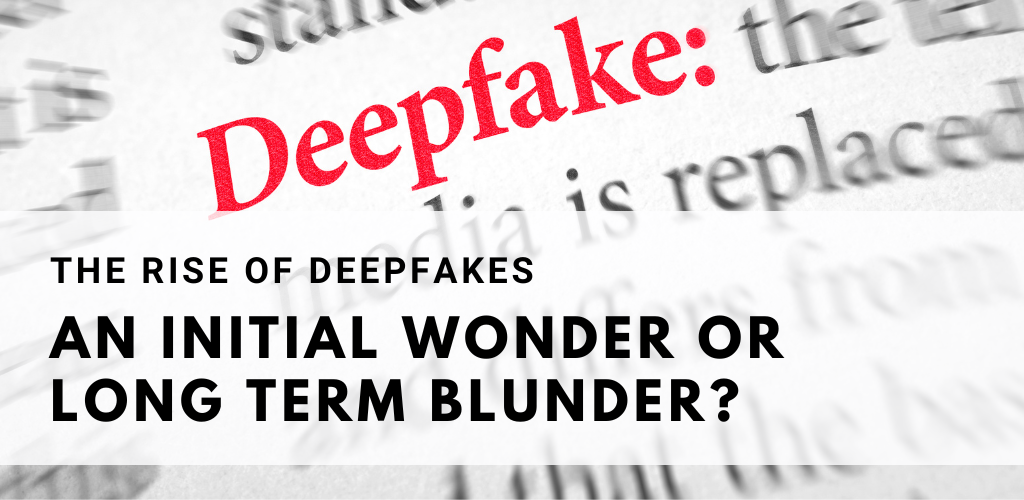The deceptive form of AI image, content, video and audio creation is termed as deepfake. Deepfake technology can create or manipulate digital content such as images, videos and audios and makes it hard for the users to distinguish it from authentic content.

The 21st century bears testimony to the greatest technological boom that humanity has ever witnessed, with AI being the most dominant. AI has already made to thousand of debates and discussions either as the topic being discussed or as the guide for researching, managing etc. Indeed AI is powerful beyond imagination but with power comes great responsibility. AI has the power to create images, videos and even do audio mimics. This might initially sound very innovative and sensational which in fact it is however, what if all this content created by AI is deceptive? What if it intends to disturb a person emotionally? What if it helps the criminals in acing cybercrimes? What if it erodes the public confidence in the democratic institutions?
The deceptive form of AI’s image, content, video and audio creation is termed as deepfake. Deepfake technology can create or manipulate digital content such as images, videos and audios and makes it hard for the users to distinguish it from authentic content. Deepfakes are blurring the divide between reality and fiction in a way that challenges our very own perception of truth in the digital world.
Deepfake Technology As An Initial Wonder
Undoubtedly, the Deepfake technologies were created for the benefit of the humanity. They have an unexplored potential which can bring more positivity and transform the world for betterment. The deepfake technology can be exclusively used in the education sector to create educational videos which are more interactive, engaging and impactful. The content that it can create to bring complex subjects to life is far away from the reach of the traditional methods. It gives wings to the imaginative quotient of ours and preps us for a future where technology will be always around us. It can also be used in the entertainment sector as it can help in achieving heights of more realistic visual effects leading to highly immersive audience and gaming experience. One of the most potential uses of this technology can be its use in simulations. For training in aviation, military and healthcare this technology can bring a revolution by making the real life simulators more enhanced and practical. It will help us in creating professionals that are better equipped for real world situations, as the simulations that trained them would be more authentic, immersive and realistic. It can also help the businesses and content creators in their marketing strategy execution by making it more relatable and personalized. The deepfake technologies can be put to effective use for which they were primarily created however they do have a darker side!
Deepfake Technology As A Long Term Blunder
Deepfake technology might be used to transmit misleading information or propaganda by making fake films or audio recordings of individuals saying or doing things they never said or did. This may have detrimental effects on public confidence in institutions, cause political unrest, or even provoke violence. Deepfake technology has the ability to breach people's privacy by producing phony audio or video recordings of them without their permission. Deepfake technology might be used to make fake films or audio recordings of persons that are humiliating, unpleasant, or detrimental to their reputation. The people portrayed in the fraudulent content may suffer from bodily injury or emotional suffering as a result. In recent times, we have seen some of our famous celebs’ videos of deepfakes going viral over the internet, causing significant impact on their mental health and well-being. This might be considered as a terrible beginning of a gloomy future if initiatives will not be directed to control it. It has opened up several ways to blackmail people and carry out frauds and scams.
Deepfakes are an example of how creative technology can be, but their moral repercussions serve as a sobering warning that creativity needs to be restrained with responsibility. Not just responsibility but an ethical responsibility.
Deepfakes: Awareness & Control
In this ever advancing world all new technologies will have their own pros and cons and our focus should be on optimizing the pros and regulating the cons. We must not deny the technology, instead we must administer it like a pro, because the possibilities that it has laid out in front of us are revolutionary and can be harnessed in the favour of the mankind. The emergence of deepfakes compels us to consider the fine line that must be drawn between innovation and maintaining our ability to trust our visual and aural perceptions. The battle is shifting from pixels to ethics as deepfake technology develops, necessitating a mutual commitment to ethical AI development.
Here are some tips to keep you safe from bearing negative consequences of deepfake technology:-
1. Make sure all the audio and video content you see and listen to are authentic by checking them twice. To spot a deepfake, keep an eye out for strange motions or strange distortions.
2. Make sure someone is who they claim to be before you believe someone you find online.
3. Some firms, such as Intel, are developing real-time technologies to detect deepfakes. One even exists that uses a person's facial 'blood flow' to determine their authenticity.
4. Gather knowledge about the various kinds of deepfake and advise people to exercise caution when viewing it.
5. Authorities are still working out how to safeguard citizens from the negative effects of deepfake technology. Laws to prevent its misuse are being considered.
6. Zero Trust represents an entirely new perspective on computer security. Presume your computers and network have already been hacked, and never blindly believe anything without first doing some investigating.
7. To reduce the likelihood of a deepfake assault, adhere to some fundamental cybersecurity guidelines: use strong passwords, routinely backup your data, maintain the security of your systems, and inform others.
“Deepfake detection techniques will never be perfect. As a result, in the deepfakes arms race, even the best detection methods will often lag behind the most advanced creation methods.” – John Villasenor, Professor of Electrical Engineering, Law, Public Policy, and Management Faculty Co-Director, UCLA Institute for Technology, Law and Policy. This serves as an eye-opener for us, that now all we can do is to be cautious and implement our strategies to combat it.
In a world where deepfakes can make the unreal appear real, the essence of truth becomes a precious commodity. In a world where fake can look real, can we count on what we see? AI's amazing, but it needs a reality check. Do we surf the tech wave wisely or drown in a sea of deceit? The choice is clear—stay savvy in the digital ride or lose sight of truth in the tech tide.
